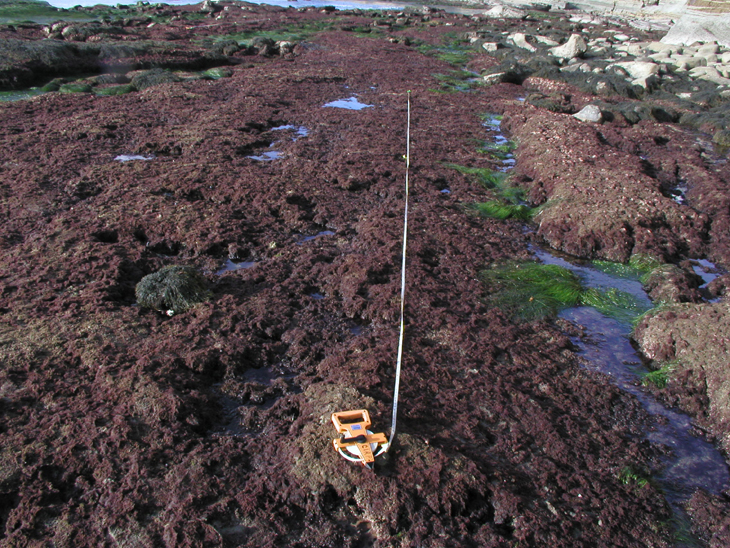Red Algal Turf - Transects | MARINe
Red Algal Turf - Transects
Last updated March, 2012
Previous Species | Next Species
Red algal turf is a mixed species assemblage of low-growing (<7 cm high) algae that carpets the middle intertidal zones of coastal reefs, particularly in southern California. Species composition within the turf community varies geographically. In San Diego County this turf can contain as many as 67 types of small red, brown, and green algae; however, red algae predominate - in particular calcium carbonate containing articulated coralline algae of the genus Corallina. (Stewart & Myers 1980; Stewart 1982; Stewart 1989a,b).
Red turf is best developed on relatively flat reefs where the algal mat forms a meshwork that traps sand and shell particles. By cementing firmly to the rock, the perennial calcareous algae form a low, but highly structured thicket that supports diverse epiphytic plants and infaunal animals. These smaller, inconspicuous organisms are of high ecological importance due to their abundance, high productivity, and importance as prey for larger organisms like shore birds (Brown and Taylor 1999). The sea anemone, Anthopleura, is the most conspicuous invertebrate within the turf assemblage. Turf may also enhance recruitment of mussels by providing attachment surfaces and a relatively sheltered micro-environment. Typically, the algal turf zone is located just above the surf grass zone, because turf is better able to withstand desiccation (Stewart 1989a). The Corallina species dominating the turf can bleach and die-back during daytime exposures to dry air, or filaments may be broken off by storm waves, but erect portions grow back from the crusts that persist after such disturbances (Stewart 1989b). They also are highly resistant to sand abrasion and burial which commonly occurs on low-sloping reefs. Corallina crusts can survive more than a year under sand; once re-exposed, they regain pink color and start growing erect portions within two weeks (Stewart 1989b).
Red algal turf was chosen for long-term monitoring at San Diego County sites because it is widespread in the middle intertidal zone; may bleach or die in response to oil, municipal wastes, or other pollutants (Foster et al. 1988); and typically occurs on flat reefs where most tidepool visitors walk during mid and low tide periods. Trampling can “wear down” the turf, break crusty Corallina filaments, and crush tiny invertebrate inhabitants. Huff (2011) conducted experimental trampling studies in San Diego, finding that bare space increased in trampled plots, and that trampled plots exhibited shifts in invertebrate species composition as well as significant declines in marine life richness and abundance.


